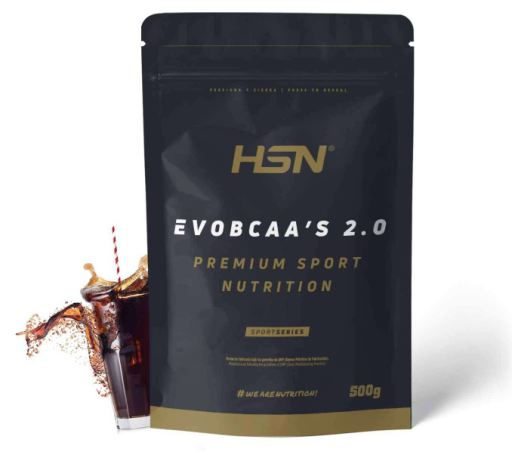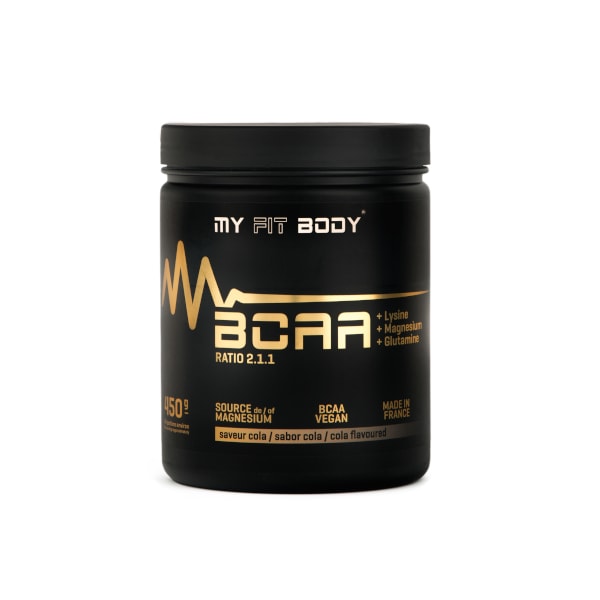If you don’t already know Fitenium is a free, mobile, video-based social network for athletes who train strength or bodyweight exercises. At Fitenium users can follow their performance, compete and get discounts in nutrition and sports equipment stores. Download it here.
The supplement industry is a multi-billion dollar industry, and in the case of BCAAs (Branched Chain Amino Acids), it is growing on the premise of improving anabolic state by stimulating protein synthesis. Aside from its effect on increasing muscle mass, much has been said about its effect on reducing muscle damage and reducing central fatigue, but how true are these claims?
 What is an amino acid?
What is an amino acid?
Second, proteins are macromolecules that are part of every cell in the body and, in addition to producing enzymes, hormones, or neurotransmitters, they are also parts of blood, bone, or muscle.
There are 20 amino acids, 9 of which are essential. This means that the body cannot synthesize large amounts of itself and therefore must be taken from the diet. The rest of the amino acids are known to be non-essential and can be produced in adequate amounts by the body on its own, so there is no need to include them in the diet.
The organism for the synthesis or construction of proteins, whether muscular or of any other type, needs amino acids. A limiting factor in protein synthesis is that the body has sufficient amounts of all the essential amino acids, since the body itself can produce the non-essential amino acids.
BCAAs in particular are part of the essential amino acids and there are three types: leucine, isoleucine and valine. They receive another name due to the peculiarity that they have branched side chains in their structure. The growing popularity of BCAAs in the supplement industry is due to the fact that BCAAs, or rather leucine, have a strong ability to stimulate one of the most important anabolic cell signaling pathways, mTORC1 (a target of rapamycin in mammals). Increasingly complex 1 or mammalian cell targets of rapamycin).
BCAAs and protein synthesis
First of all, it must be said that most of the work observing the positive effects of BCAAs on protein synthesis is done in rodents. The procedures and doses used in these studies are not applicable to humans due to differences in physiologic and cellular signaling pathways.
However, in humans, the administration of BCAAs, whose leucine content is the main cause, can stimulate protein synthesis, but it is known that the administration of the remaining essential amino acids is necessary to optimize the response. Being done. In the cited study, the response in protein synthesis when BCAAs were administered was 50% lower than when whey or casein protein was administered. BCAAs increased protein synthesis by 22%, but not as much as complete protein.
All this can be explained because the body needs all the essential amino acids to build muscle protein. Even large doses of BCAAs cannot increase protein synthesis beyond a certain point due to one or more restricted amino acids. It is not enough to support this process.
In English, the concept of limited or speed-limited amino acid provides a large amount of BCAAs and limits the remaining essential amino acid. The quality of synthesis is not due to the contribution of BCAAs but to an insufficient contribution of essential amino acids. It is also necessary that the duration of the dwellings be high. It’s cool, but more for building a house:
In any case, the bottom line is that building muscle requires better protein synthesis than breaking it down, and to trigger long-lasting protein synthesis, not just the three essential amino acids, but the whole gamut. It is required.
BCAA and mTORC1 anabolic signaling pathways
As mentioned above, BCAAs stimulate mTORC1, one of the most important anabolic cell signaling pathways, due to their leucine content. Protein synthesis and cell signaling are not the same, but both are necessary with strength training to trigger muscle growth.
This needs to be explained, as many believe that flipping a ‘switch’ in the mTOR pathway is enough to trigger muscle growth, but this is not the case. In that case, you don’t even need to train.
To explain the relationship between protein synthesis and cellular signal transmission, we must compare it to the work of the building, and to the beginning of all work that can be done. It may be called: mason, electrician, carpenter or pipe builder… but when they arrive, they are assembled. They discover that everyone has a bag of tools, a handful of cables and pipes, and they all understand it. What is needed (transmission of cell signals) to build the building (protein synthesis) contains only a small amount of that substance (the remaining essential amino acids). Sin BCAA)
In summary, BCAAs can stimulate the mTOR pathway but not maximize protein synthesis either in size or duration.
Maximize muscle protein synthesis (MPS)
What effect do BCAAs have on muscle recovery?
Another benefit that results from BCAAs is the positive impact on training recovery due to the attenuation of muscle damage. In fact, the scientific community has not yet agreed on this issue. Some studies look at these effects and others do not.
A recent study found that BCAAs reduced myalgia after intense eccentric training, but these effects were negligible if the protocol was repeated on a diet containing at least 1.2 grams of protein per kilogram of body weight. Era. Here you can see how important your total daily protein intake is to your BCAA intake.
In another 2010 study, BCAAs reduced muscle soreness in untrained men who participated in the study after taking 14 grams of BCAAs daily for 3 days post-workout, but with no change in muscle function. It was observed that this was not the case.
However, the International Association for Sports Nutrition (ISSN) needs further study to see if BCAAs are supplements that can improve post-workout recovery, especially in high-protein diet situations. There is.
How do BCAAs affect fatigue in endurance aerobic sports?
These fatty acids are transported by the protein carrier albumin and can also transport tryptophan. This competition between fatty acids and tryptophan leaves more free tryptophan in the blood that travels to the brain, crosses the blood-brain barrier, and increases the synthesis of serotonin, a neurotransmitter that increases fatigue.
A transporter is required for tryptophan to cross the blood-brain barrier. This transporter is the same transporter that BCAAs use to cross this barrier, so increased BCAA consumption competes with tryptophan, many of which cross the blood-brain barrier and cause fatigue. It’s supposed to go away.
However, to date, this hypothesis has not been proven, because there is only one old study from 1998 that observed better performance when taking BCAAs.
So should you take a BCAA?
In fact, if your diet already provides enough protein, it’s not necessary. It’s relatively common for us to cover these amounts for protein amounts of 1.5 to 2.5 grams per kilogram of body weight, depending on the person, physical activity, and goal, and it’s easy for most people.
However, if you want to get BCAAs, it is important that these are accompanied by the remaining essential amino acids if your goal is to gain muscle mass.
If you’re an endurance athlete and think it’s worth trying to reduce fatigue, your typical intake is about 20 grams of BCAAs and at least 2-10 grams of leucine. The time of consumption can be before, during or after training.
BCAA supplements are usually sold in a 2:1:1 or 4:1:1 ratio and there is always more leucine present. A 2:1:1 supplement is sufficient. More leucine than we have seen so far does not produce additional effects.






